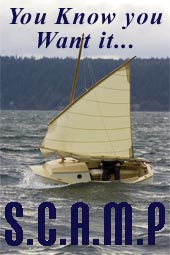11' Foot Dinghy by F. K. Lord
The 11-foot dinghy shown herewith was designed by Mr. F. K. Lord, and should prove to be a good service able craft. Mr. Lord has built and owns a dinghy of the same type 10 feet long, and in this he has embodied features that he found would improve the smaller one. Anyone at all familiar with tools could construct this boat during the winter, and at a very slight cost. All that is needed is a barn or shed in which to work. The shape of the molds all are shown in the plan, and can be of spruce, with the exception of the transom, which should be of mahogany, as it will be permanent, while the rest will be only temporary. These can be set up, secured, and the stem made of hackmatack. The sides can be either of cedar or white pine, and should be in one length, four planks being required, or two if wide enough to split or long enough to cut in two. The top stake should lap over the bottom one, and be riveted to it the same as in a lapstrake boat. The bottom boards are put on the same as any flat bottom skiff and secured to the sides and stringer shown on the midship section. The wearing battens are put on the edges of the bottom boards, to protect the bottom in hauling up on the beach while the wide strip in the center is to act as a stiffener and support the center of the bottom. The knees are put in to stiffen and hold the sides in place, together with breasthook at the bow and the knees at the side and transom. The molds should not be removed until after the seats are put in as otherwise the sides will not retain their shape. The seats and other interior fittings can be of mahogany, as it stands the weather well and gives a better finish.
Thirteen-Foot Launch by F. K. Lord
The above plan shows a good type of launch that is small enough to be within the capabilities of the amateur builder and one that can be set up in a small work shop. This boat could be built at a very small expense, and fitted with a simple 2-cycle motor of about one and a half or two horse power would give the enthusiastic power-boater any amount of sport and varied experience. The boat could be built with a flat keel of 4-inch oak, sprung to shape with the deadwood fastened on outside. The frames or timbers should be about 1/2 x 3/4 inches, spaced 6 inches on centers and the planking 1/2 inch pine or cedar. By carrying the cockpit a little farther aft and making it square across the after end a very comfortable seat could be obtained. As the scale is given on the drawing the measurements necessary for enlarging the plans to build from can be taken off by making a scale on a strip of paper like the one shown on the plan. Complete instructions for laying down the lines, making moulds, planking, etc., can be gotten from our How to Build a Motor Launch, which describes all the various parts of the work so simply that the least technical mind can readily understand them.
The dimensions of this boat, which was designed by Mr. F. K. Lord, axe as follows:
|








